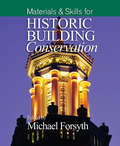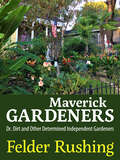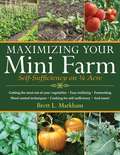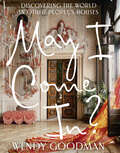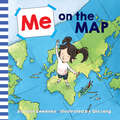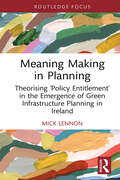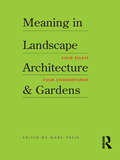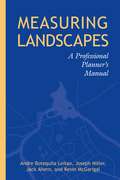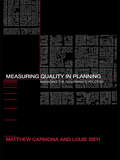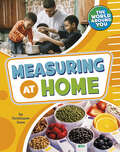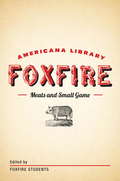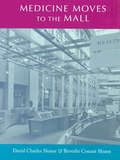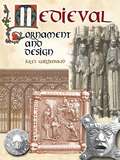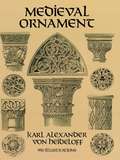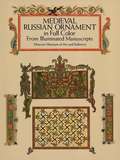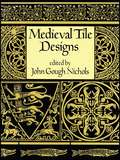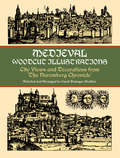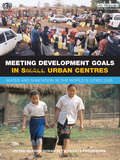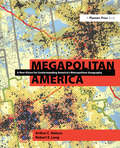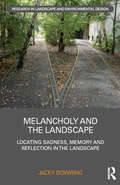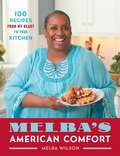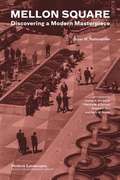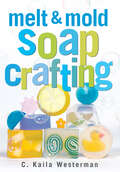- Table View
- List View
Materials and Skills for Historic Building Conservation (Historic Building Conservation)
by Michael ForsythThis book is the third in a series of volumes that combine conservation philosophy in the built environment with knowledge of traditional materials, and structural and constructional conservation techniques and technology: Understanding Historic Building Conservation Structures & Construction in Historic Building Conservation Materials & Skills for Historic Building Conservation The series aims to introduce each aspect of conservation and to provide concise, basic and up-to-date knowledge for architects, surveyors and engineers as well as for commissioning client bodies, managers and advisors. In each book, Michael Forsyth draws together chapters by leading architects, structural engineers and related professionals to reflect the interdisciplinary nature of conservation work. The books are structured to be of direct practical application, taking the reader through the process of historic building conservation and emphasising throughout the integrative teamwork involved. The present volume - Materials & Skills for Historic Building Conservation – describes the characteristics and process of decay of traditional materials which inform the selection of appropriate repair techniques. It provides essential information on the properties of the principal traditional external building materials. Their availability, sourcing and environmental impact is covered, as well as the causes of erosion and decay, and the skills required for their application on conservation projects. It covers the main most commonly used materials and conservation techniques including stone, brickwork, lime products, concrete, iron and steel, timber, wattle and daub, and glass, Thirteen chapters written by the experts present today's key issues in materials and skills for historic building conservation: Gus Astley, Patrick Baty, Charley Brentnall, Michael Bussell, Michael Forsyth, Tony Graham, Chris Harris, David McLaughlin, Brian Ridout, Mike Stock, Geoff Wallis, Ian Williams, Rory Young
Materials for Interior Environments
by Corky BinggeliOrganized by types of materials and applications, this guide helps designers successfully address material evaluation and selection of interior components. Engagingly written, highly detailed, and helpfully illustrated with more than 550 color illustrations, Materials for Interior Environments is a comprehensive guide to everything a designer needs to know about the materials available for interiors--from aesthetic qualities to manufacturing and fabrication, applications, installation and maintenance, and specifications for materials used in commercial and residential applications.
Maverick Gardeners: Dr. Dirt and Other Determined Independent Gardeners
by Felder Rushing“Be forewarned that this book honors people like the woman in my hometown who paints the numbers of her favorite NASCAR drivers on her elephant ears, and a Tokyo gardener with over a hundred bonsai plants.” So says renowned garden journalist Felder Rushing in his new book Maverick Gardeners: Dr. Dirt and Other Determined Independent Gardeners. In this book, Felder delves deeply into the psychology of what motivates and sustains the Keepers of the Garden Flame. For thousands of years, a loosely connected web of unique, nontraditional gardeners has bonded people across race, culture, language, and other social conventions through sharing unique plants and stories. Found in nearly every neighborhood worldwide, these “determined independent gardeners” (DIGrs) are typically nonjoiners who garden simply and exuberantly, eschewing customary horticultural standards in their amateur pursuits of personal bliss. Included in Maverick Gardeners are classic “passalong plant” lists, a dollop of how-to, numerous color photographs, and thought-provoking essays on quintessential tools, sharing with others, getting away with wildflowers in suburbia, and organizing a plant swap. The centerpiece of this unique gardening journey is the no-holds-barred story of a ten-year cross-cultural collaboration between the horticulturist author and a flamboyant rebellious gardener who called himself Dirt. Through swapping plants and garden lore—and rubbing shoulders with fellow DIGrs—they unraveled their shared humanity. From the practical to the inspiring, Maverick Gardeners is the perfect book for those nonconformist souls who see no sense in trying to fit in and follow the footpaths of others.
Maximizing Your Mini Farm: Self-Sufficiency on 1/4 Acre
by Brett L. MarkhamMini farming describes a holistic approach to small-area farming that will show you how to produce 85 percent of an average family's food on just a quarter acre-and earn $10,000 in cash annually while spending less than half the time that an ordinary job would require. Now expanding exponentially on his bestselling Mini Farming: Self-Sufficiency on ¼ Acre, Brett Markham gives you tips, tricks, and planning advice on how to make the most of your mini farm. New topics include: -Soil and Fertility yy Tools and Techniques-Planting Guides and Seeders-Easy Trellising -Weed Control Techniques-Greater Food Self-Sufficiency-Making Your Own Country Wines-Making Your Own Vinegars -Making Cheese at Home-Cooking for Self-Sufficiency Keep your costs down and production high with this complete guide to maximizing your mini farm-whether it's a rooftop urban garden, a suburban backyard, or a more substantial plot of land. Materials, tools, and techniques are detailed with tables, diagrams, and 200 color illustrations and author photographs.
May I Come In?: Discovering the World in Other People's Houses
by Wendy GoodmanNew York magazine&’s interiors editor shares some of her most memorable house profiles in this stunning and inspiring visual tour. For May I Come In?, design editor extraordinaire Wendy Goodman visits seventy homes that express their owners&’ spirit and passions. In this pantheon, imagination and originality hold sway: Artists and eccentrics are the equals of aristocrats and the mandarins of design. Alba Clemente&’s closet is a Renaissance theater; Amy Sedaris built a playroom (but not for children); Andrew Solomon houses his guests in an igloo; Richard Avedon&’s private walls were bulletin boards; Kathy Ruttenberg&’s house is an animal kingdom; Jay Maisel called a former bank with seventy-two rooms home. Every room has a story to tell and a purpose for being. A self-described design hunter, Goodman spent thirty years seeking extraordinary living spaces. In her long career, she has found three things to be true. The first is that curiosity and never giving up will get you everywhere. The second is what Diana Vreeland stated best when she wrote, &“Few things are more fascinating than the opportunity to see how other people live during private hours.&” The third is that houses never lie. These principles underscore her search for individuality, human interest, and authenticity in design.May I Come In? is profusely illustrated with superb images by leading interior photographers, as well as Goodman&’s own snapshots and memorabilia related to her quests. It is an irresistible visual record of the art of living by one of its most astute observers.&“Page after page reveals interiors that practically vibrate with charisma, while others wax a poetic minimalism that, despite a lack of things, overwhelm with grace.&” —Vogue &“When it comes to the New York design scene, Wendy Goodman is positively an institution.&” —Town & Country
Me on the Map (Me. . Books! Ser.)
by Joan SweeneyMaps can show you where you are anywhere in the world! A beloved bestseller that helps children discover their place on the planet, now refreshed with new art from Qin Leng. Where are you? Where is your room? Where is your home? Where is your town? This playful introduction to maps shows children how easy it is to find where they live and how they fit in to the larger world. Filled with fun and adorable new illustrations by Qin Leng, this repackage of Me on the Map will show readers how easy it is to find the places they know and love with help from a map.
Meaning Making in Planning: Theorising ‘Policy Entitlement’ in the Emergence of Green Infrastructure Planning in Ireland
by Mick LennonPlanning theorists normally focus on issues of contest and critique. The field of planning theory is thereby replete with studies of conflict, collaboration and criticism. Considerably less critical attention is afforded to policy approaches that emerge, evolve and are widely adopted in the apparent absence of discord. This book addresses this knowledge gap. A case study of the emergence of green infrastructure policy in Ireland is used to both inform and illustrate a theory of ‘Policy Entitlement’. This interpretive approach focuses on meaning making in context to explain the counter-intuitive processes through which a new policy concept can emerge and reprofile planning activities by producing the seemingly pre-existing objective reality to which such policy is then applied and the discipline (re)orientated. This approach accounts for how a new planning concept can appear to resolve problematic policy ambiguity by suspending disagreement on issues where dispute could be expected. This book will be of interest to those studying planning theory and the policy process, as well as those concerned with the undertheorized but swift rise to prominence of green infrastructure planning.
Meaning in Landscape Architecture and Gardens
by Laurie Olin Marc Treib Susan Herrington Jane GilletteWhile we all live our lives in designed landscapes of various types, only on occasion do we consider what these landscapes mean to us and how they have acquired that significance. Can a landscape architect or garden designer really imbue new settings with meaning, or does meaning evolve over time, created by those who perceive and use these landscapes? What role does the selection and arrangement of plants and hard materials play in this process and just where does the passage of time enter into the equation? These questions collectively provide the core material for Meaning in Landscape Architecture and Gardens, a compendium of four landmark essays written over a period of twenty years by leading scholars in the field of landscape architecture. New commentaries by the authors accompany each of the essays and reflect on the thinking behind them as well as the evolution of the author’s thoughts since their original publication. Although the central theme of these writings is landscape architecture broadly taken, the principal subject of several essays and commentaries is the garden, a subject historically plentiful in allusions and metaphors. As a whole Meaning in Landscape Architecture and Gardens offers the general reader as well as the professional a rich source of ideas about the designed landscape and the ways by which we perceive, consider, react, and dwell within them – and what they mean to us. The essays have been perennial favorites in landscape courses since their original publication in Landscape Journal. Bringing them together – bolstered by the new commentaries – creates a book valuable to all those creating gardens and landscapes, as well as those teaching and studying these subjects.
Measuring Landscapes: A Planner's Handbook
by Jack Ahern Joseph Miller Kevin Mcgarigal Andre Botequilha LeitaoThis practical handbook bridges the gap between those scientists who study landscapes and the planners and conservationists who must then decide how best to preserve and build environmentally-sound habitats. Until now, only a small portion of the relevant science has influenced the decision-making arenas where the future of our landscapes is debated and decided. The authors explain specific tools and concepts to measure a landscape's structure, form, and change over time. Metrics studied include patch richness, class area proportion, patch number and density, mean patch size, shape, radius of gyration, contagion, edge contrast, nearest neighbor distance, and proximity. These measures will help planners and conservationists make better land use decisions for the future.
Measuring Quality in Planning: Managing the Performance Process
by Matthew Carmona Louie SiehThis book deals with one of the current major debates in planning: how to measure the quality and effectiveness of the output of the planning process. It deals with issues of defining quality, public sector management, the use of indicators and the planning process. Although case study material is drawn from UK practice this topic is universal and the authors include discussions of international practice and experience.
Measuring at Home (The World Around You)
by Christianne JonesYour house is packed with big things and small things and everything in-between. How tall is your refrigerator? How long is your bed? How wide is your door? Colorful photographs and interactive, rhyming text will have early learners ready to measure after reading this picture book.
Meats and Small Game: The Foxfire Americana Library (4) (The Foxfire Americana Library)
by Inc. Foxfire FundGreat for hunters, fishermen, and adventurous cooks, this illustrated entry in the Foxfire Americana Library shares a wealth of information from Appalachian experts on how to dress and cook meats and small game, including fish, hog, raccoon, rabbit, squirrel, turtle, and deer.
Medical and Dental Space Planning: A Comprehensive Guide to Design, Equipment, and Clinical Procedures
by Jain MalkinTHE UPDATED DEFINITIVE REFERENCE ON MEDICAL AND DENTAL OFFICE DESIGN Medical and Dental Space Planning is an indispensable guide to the myriad of details that make a medical or dental practice efficient and productive. The unique needs of more than thirty specialties, as well as primary care, are explained in the context of new technology and the many regulatory and compliance issues influencing design. Concepts are also presented for ambulatory surgical centers, diagnostic imaging, clinical laboratories, breast care clinics, endoscopy centers, community health centers, radiation oncology, and single-specialty and multispecialty group practices and clinics. A thorough review of the latest dental technology and many creative space plans and design ideas for each dental specialty will be of interest to both dentists and design professionals. Important topics like infection control are top of mind, influencing every aspect of dental office design. An "inside look" at what goes on in each specialist's office will familiarize readers with medical and dental procedures, how they are executed, and the types of equipment used. Technology has radically impacted medical and dental practice: digital radiography, electronic health records, mobile health devices, point-of-care diagnostic testing, digital diagnostic instrumentation, CAD/CAM systems for digital dental impressions and milling of restorations in the dentist's office, portable handheld X-ray, and 3D cone beam computed tomography for dentists all have major implications for facility design. The influence of the Affordable Care Act is transforming primary care from volume-based to value-based, which has an impact on the design of facilities, resulting in team collaboration spaces, larger consultative examination/assessment rooms, and accommodation for multidisciplinary practitioners who proactively manage patient care, often in a patient-centered medical home context. The wealth of information in this book is organized to make it easy to use and practical. Program tables accompany each medical and dental specialty to help the designer compute the number and sizes of required rooms and total square footage for each practice. This handy reference can be used during interviews for a "reality check" on a client's program or during space planning. Other features, for example, help untangle the web of compliance and code issues governing office-based surgery. Illustrated with more than 600 photographs and drawings, Medical and Dental Space Planning is an essential tool for interior designers and architects as well as dentists, physicians, and practice management consultants.
Medicine Moves to the Mall (Center Books on Space, Place, and Time)
by David Charles Sloane Beverlie Conant SloaneThe shopping mall seems an unlikely place to go for health care services. Yet, the mall has become home to such services as well as a model for redesigning other health care facilities. In Medicine Moves to the Mall, David Charles Sloane and Beverlie Conant Sloane document the historical changes to our health care landscape by exploring the interactions between medicine and place. This unique combination of architectural history and the history of medicine provides a thought-provoking analysis of the geography of the practice of medicine.The book presents three essays, each accompanied by a gallery of historical and recent photos. The authors discuss the rise of modern hospitals and how they were shaped into scientifically sterile and humanly stark "medical workshops." Starting in the 1970s, hospital facilities were altered in appearance to become more friendly and welcoming. The integration of a shopping mall's spaciousness and open design with technology and scientific innovation served in "humanizing the hospital." Most recently, the accessibility and convenience of shopping center and roadside clinics have invited Americans to go "shopping for health" in the increasingly commercialized medical system.Medicine Moves to the Mall will appeal to scholars and professionals in fields ranging from health care to cultural geography and from urban studies to architectural history, as well as to readers interested in the shifting status of medicine in American society.
Medieval Ornament and Design
by Jules GailhabaudThis lavish archive of exquisite engravings and designs--originally created in the mid-nineteenth century for the professional artist and architect--contains some 200 splendid illustrations, expertly adapted from decorative as well as utilitarian features of medieval cathedrals, churches, tombs, houses, shops, public buildings, and other structures. Encompassing a wide variety of styles, the designs include finely detailed panels, gawking gargoyles, marvelously carved pillars and pedestals, exquisite ironwork patterns, decorative stonework, magnificent stained glass windows, moldings enhanced with intricately woven motifs, and much more.Artists, designers, and craftworkers will find wide use for these versatile, royalty-free illustrations. Students of architecture, art historians, and lovers of ornamental art will delight in the pure beauty of this magnificent collection.
Medieval Ornament: 950 Illustrations (Dover Pictorial Archive)
by Karl Alexander HeideloffThe decorative arts of the Middle Ages -- richly ornate, filled with religious and mythic symbolism -- were especially remarkable for the complexities of their design and their inspired craftsmanship. This fascinating volume presents nearly 1,000 illustrations of medieval ornament, consisting mostly of architectural elements from German Romanesque and Gothic churches and other buildings.Originally compiled by the German architect, painter, and engraver Karl Alexander von Heldeloff (1788-1865) as a source of study and inspiration for practicing artists and architects, this grand pictorial archive has been exactingly reproduced from a rare original edition, complete with new English translations of the German captions.The book is filled with precisely detailed engravings of doors, windows, decorative stonework, columns, pedestals, and more. It remains a richly varied resource of authentic images of medieval ornament, ideal for students of architecture and the decorative arts and essential for graphic artists and designers in search of royalty-free illustrations.
Medieval Russian Ornament in Full Color: From Illuminated Manuscripts (Dover Pictorial Archive)
by Moscow Museum of ArtThis beautiful book illustrates the splendid ornamental lettering and decorative art in illuminated Russian manuscripts dating from the 10th through the 16th centuries. It contains over 1,000 motifs reprinted in full color from a rare book of design first published in France in 1870. Among the designs are richly embellished letters from the Cyrillic and Greek alphabets, elaborate manuscript page heads and ornate corners and borders. Many of the designs incorporate mythological creatures, religious iconography, and design elements deeply rooted in early Slavic and Byzantine cultures. There is a strong Celtic flavor as well. On page after page, the distinctive motifs in this collection reflect the unique heritage of Russian design, a rich amalgam of East and West. Students of graphic design and the decorative arts will find the book an invaluable reference. Graphic artists will find these rare, copyright-free examples of medieval ornament, which lend themselves to color copying, ideal for many kinds of projects.
Medieval Tile Designs
by John Gough NicholsLittle remains of the decorative ceramic tiles that once paved the floors of medieval churches and cathedrals. Abraded by time and use, stolen by collectors, or covered by new flooring, these handsome ornamental paving stones (also known as "encaustic tiles") have become rarities. This practical, inexpensive, and comprehensive archive -- originally published in the mid-19th century -- has preserved many of those ancient designs for future generations. It represents an invaluable source of design inspiration for permission-free use by today's artists and craftspeople. Adapted largely from tile motifs that once adorned English churches in Winchester, St. Cross, Romsey, and Warblington, 146 handsome images display a host of characteristically medieval patterns -- crosses, churches, fleur-de-lis, stylized plant forms, mythological creatures, stars, abstract and geometric figures, and other authentic elements. These rich and evocative designs can be used to enhance a host of art and craft projects: wood burning, leathercraft, and stained glass work; fabric painting, ceramics, enameling, stenciling, or any other project calling for unique and powerful attention-getters.
Medieval Woodcut Illustrations: City Views and Decorations from the Nuremberg Chronicle
by Carol Belanger GraftonPerhaps the most elaborately illustrated book of the 15th century, The Nuremberg Chronicle ranks with the Gutenberg Bible in terms of its magnificent craftsmanship and unsurpassed excellence of design. A rich selection of plates from this 1493 history of the world, long a treasured favorite of collectors, is now available in this inexpensive edition.This volume lovingly preserves the full grandeur of the original woodcuts, designed by the celebrated artists Michael Wolgemut and Wilheim Pleydenwurff. Some scholars believe that since Albrecht Dürer was Wolgemut's student at the time of the book's production, it is possible that he too contributed to the illustrations of the Chronicle. The plates shown here depict 91 locales as they appeared in 15th century Athens, Paris, Rome, Vienna, Jerusalem, Venice, Prague, Munich, Nuremberg, Florence, and many more. Included are 51 city views, 26 of them double-page spreads, each one exhibiting a new mastery of perspective -- as this book embodies a stage in the evolution of art from the naïve to its more conscious form. An additional 143 miscellaneous illustrations of figures and decorative objects round out this volume, all of whose cuts emanated from the celebrated printing presses of Anton Koberger.
Meeting Development Goals in Small Urban Centres: Water and Sanitation in the Worlds Cities 2006
by Un-HabitatHalf of the world's people live in urban areas, and roughly a third of these live in desperate poverty without access to basic amenities. Taking on the themes of UN-HABITAT's Water and Sanitation in the World's Cities (2003), this new volume focuses on the deficiencies in the provision of water and sanitation where most of the populations of the developing world live: in towns and small cities. Drawing on extensive unpublished research and 15 commissioned papers from experts involved in designing and implementing innovative projects around the world, this is the first major study of the problems facing the smaller urban centres that are recognized to be of enormous importance by governments, international agencies, NGOs and service providers. Tackling these problems is a crucial part of development and of good governance, and critical to meeting the Millennium Development Goals. The volume will be essential reading for all professionals and researchers in the relevant fields and a valuable resource for teachers and students of urban development.
Megapolitan America
by Robert Lang Arthur NelsonWith an expected population of 400 million by 2040, America is morphing into an economic system composed of twenty-three 'megapolitan' areas that will dominate the nation’s economy by midcentury. These 'megapolitan' areas are networks of metropolitan areas sharing common economic, landscape, social, and cultural characteristics. The rise of 'megapolitan' areas will change how America plans. For instance, in an area comparable in size to France and the low countries of the Netherlands and Belgium – considered among the world's most densely settled – America's 'megapolitan' areas are already home to more than two and a half times as many people. Indeed, with only eighteen percent of the contiguous forty-eight states’ land base, America's megapolitan areas are more densely settled than Europe as a whole or the United Kingdom. Megapolitan America goes into spectacular demographic, economic, and social detail in mapping the dramatic – and surprisingly optimistic – shifts ahead. It will be required reading for those interested in America’s future.
Melancholy and the Landscape: Locating Sadness, Memory and Reflection in the Landscape (Routledge Research in Landscape and Environmental Design)
by Jacky BowringWritten as an advocacy of melancholy’s value as part of landscape experience, this book situates the concept within landscape’s aesthetic traditions, and reveals how it is a critical part of ethics and empathy. With a history that extends back to ancient times, melancholy has hovered at the edges of the appreciation of landscape, including the aesthetic exertions of the eighteenth-century. Implicated in the more formal categories of the Sublime and the Picturesque, melancholy captures the subtle condition of beautiful sadness. The book proposes a range of conditions which are conducive to melancholy, and presents examples from each, including: The Void, The Uncanny, Silence, Shadows and Darkness, Aura, Liminality, Fragments, Leavings, Submersion, Weathering and Patina.
Melba's American Comfort: 100 Recipes from My Heart to Your Kitchen
by Melba WilsonFresh from the kitchen of her legendary Harlem restaurant, Melba's, the reigning queen of American comfort food serves up one hundred delectable recipes that put her own special touch on favorite dishes--and taste just like home.Where do celebrities and foodies go for the most delicious fried chicken and eggnog waffles? To Melba's, of course! Melba Wilson is a sweet, upbeat, occasionally sassy, always genuine ambassador for the cuisine known for years as soul food but that she prefers to call American comfort food. Melba cut her culinary teeth at the iconic Sylvia's, the famed Windows on the World, and the hugely popular Rosa Mexicano. Now, as the pioneering owner of her own legendary Harlem restaurant, she proudly holds court in Melba's always-packed dining room, dishing out lovingly prepared sweet potato pie, wine-braised short ribs, BBQ turkey meatloaf, deviled eggs, and a legion of mouth-watering American classics as well as unforgettable special twists on beloved comfort foods. Now you don't have to leave the comfort of your own home to dig into her sumptuous signature recipes! With mouthwatering full-color photography and a beautiful design, Melba's American Comfort features the secrets of her irresistible home cooking, passed down from her great-grandmother and other talented generations and given her own loving variations, plus a treasure trove of delightful stories from the heart of her bustling kitchen.
Mellon Square
by Susan Rademacher Charles BirnbaumThe second volume in our Modern Landscapes series examines the evolution of Pittsburgh's first modern garden plaza. Completed in 1955 from a design by the acclaimed landscape design firm Simonds & Simonds and architects Mitchell & Ritchey, Mellon Square functioned as an urban oasis that provided downtown office workers a much-needed respite from the city's infamous smoke pollution. Now, more than six decades later, Mellon Square is undergoing a major restoration by Patricia O'Donnell of Heritage Landscapes that aims to restore this urban garden and help revitalize downtown Pittsburgh. Featuring new photography and archival material, Mellon Square is the only book to showcase the development of this iconic urban landscape.
Melt & Mold Soap Crafting
by C. Kaila WestermanCook colorful, whimsical, eye-catching soaps right in your microwave! It’s easy and fun with C. Kaila Westerman’s guide to creative soap making. Westerman’s recipes are free of harsh chemicals and she encourages you to play with colors, scents, and shapes that the whole family will enjoy — from rubber duckies to sailboats, stars, and gemstones. With an inexpensive soap base, some food coloring, and a bit of imagination, you can quickly create handy bars for kid-friendly cleaning and hours of bath time fun.
